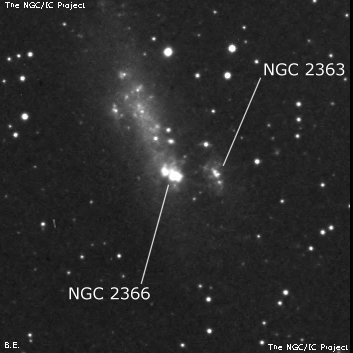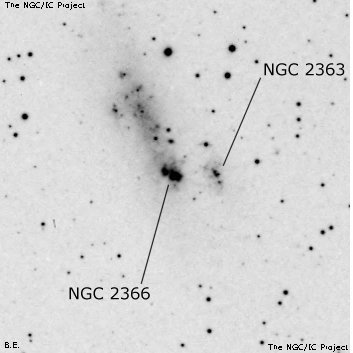NGC/IC Project Restoration Effort
(This is a very very beta version)
NGC2366


Basic Information
Location and Magnitude
Right Ascension: 7:28:54.8
Declination: +69:12:58
Constellation: CAM
Visual Magnitude: 11.1
Historic Information
Discoverer: Herschel W.
Year of discovery: 1788
Discovery aperture: 18.7
Observational
Summary description: vF, pL, mbM, vS * inv, curved tails
Sub-type: IBm
Corwin's Notes
=====
NGC 2366. See NGC 2363.
Steve's Notes
=====
NGC 2366
48" (4/15/10): The most striking feature of NGC 2366 is a prominent double knot (giant HII/starburst complex) at the SW end (also known as Mrk 71 amd NGC 2366-I). At 330x, the knot appeared very bright, elongated 3:2 E-W, ~18"x12", with two overlapping components (super star clusters A and B). A fainter and smaller knot (NGC 2366-II) was easily visible 15" E, for a total of 3 HII knots.
NGC 2363, a low surface brightness companion or detached OB association/HII region, lies 1.2' W of the bright double knot. At 330x it appeared fairly faint, moderately large, elongated 2:1 or 5:2 SW-NE, with a low but irregular surface brightness.
18" (3/19/04): at the SW end of the galaxy is a very bright knot (HII region), roughly mag 12.5 and perhaps 15" in size which responds to a UHC filter at 160x! At 323x this knot is irregular in shape (~20"x15", SW-NE) and brightness and at moments resolves into two or three components. The galaxy itself is fairly faint, large, and very elongated SSW-NNE, 3.5'x1.0', with a low surface brightness.
13.1" (1/11/86): fairly faint, very large, elongated 5:2 SW-NE, low almost even surface brightness. An unusually bright HII region is at the SW end of the galaxy (2' from the center) and appears as a "fuzzy" 12th magnitude star. Although very small, it appeared elongated SW-NE and similar to a poorly resolved double star. Definite contrast gain with OIII filter.



